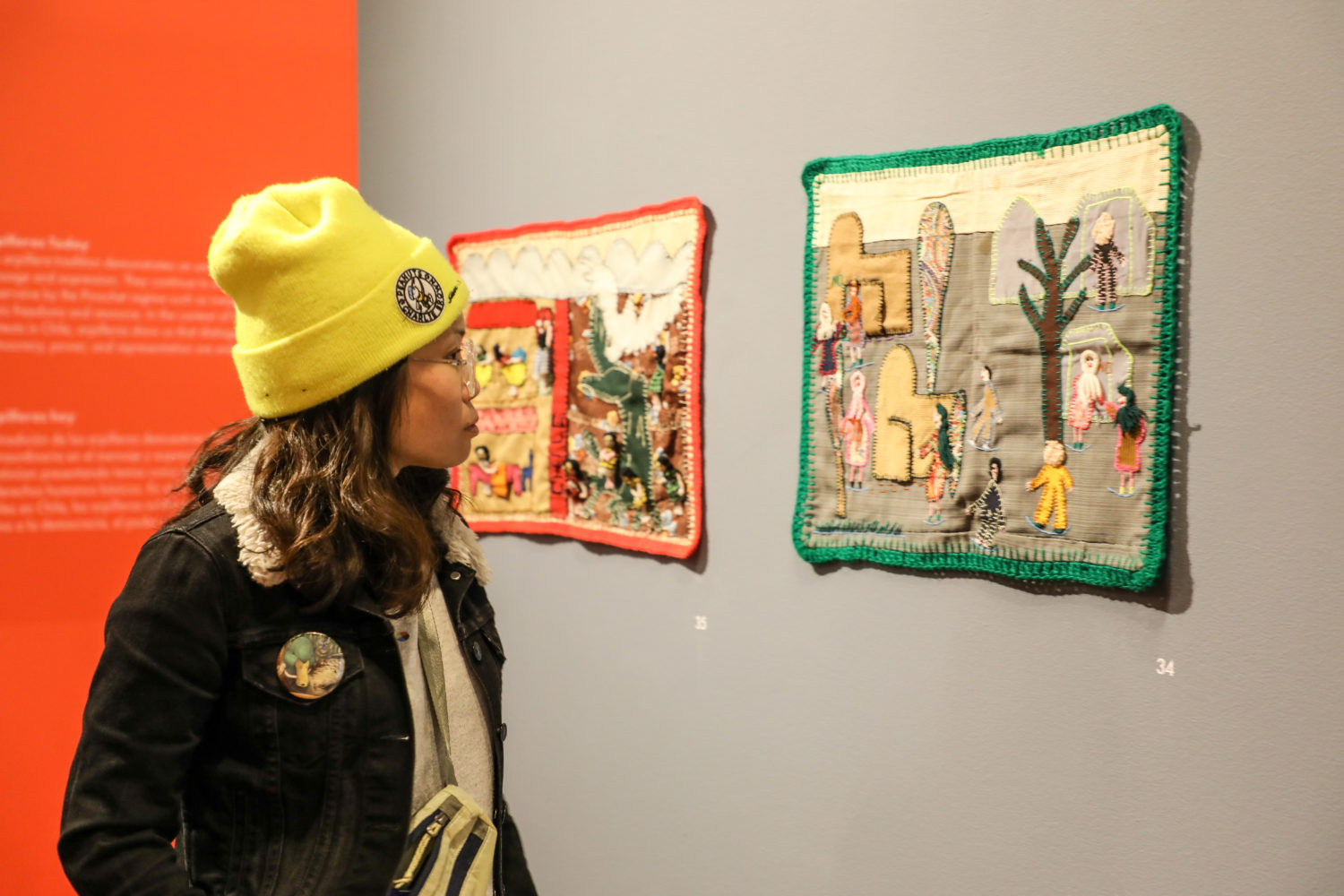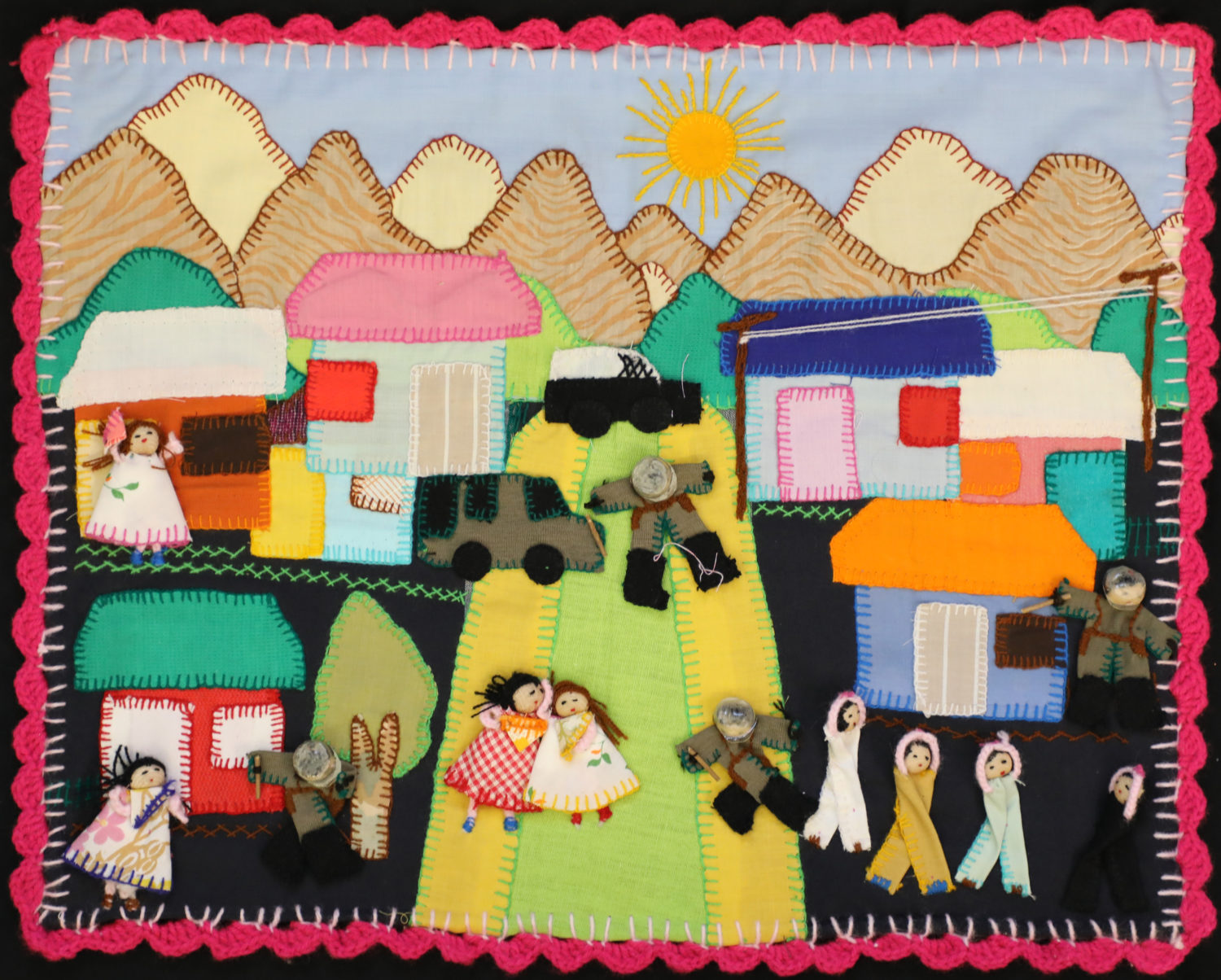An illustration of a book burning in Chile is one of many arpilleras, or small handmade textiles, created by Chile’s women in the 1970s and ’80s, on display in Arte, Mujer y Memoria: Arpilleras From Chile, an historically important exhibition on view at the Museum of Latin American Art in Long Beach through March.
The 35 approximately 15 x 19-inch embroidered depictions of life in the Latin American country in the wake of the General Augusto Pinochet’s 17-year-long regime (which ended in 1990) combine activist themes with delicate handmade needlework. The result is a politically charged show, replete with extensive wall didactics, compelling the viewer to spend time and energy absorbing its important message.
During the Pinochet regime, more than 3,000 people were murdered, tens of thousands were imprisoned, and an estimated 200,000 Chileans went into exile. As a result, most women in the country lost their families’ breadwinners as their brothers, fathers, sons and partners were made to disappear.

A visitor to Arpilleras at MOLAA
To deal with the emotional and financial devastation, women throughout Chile formed arpillera workshops to bond with and support each other, to create and sell their handmade needlework, and to smuggle their creations to the outside world. Introductory material to the exhibition reads in part, “Pinochet remained in power until 1990 and continued to supervise the military until 1998. While officials tried to hide or deny the human rights abuses conducted under his administration, the tangible nature of the arpilleras and the global attention they garnered made it impossible to deny the regime’s horrors and the lives it claimed.”
The embroidered colorful arpilleras, all folkloric in style, were created by women living with daily repression. Their pieces record their travails, while also documenting and denouncing the many human rights abuses occurring in their country — including book burning, a common experience after Pinochet’s coup d’état. The human figures in these pieces are all raised, providing them with three-dimensional aspects.
The textiles, which were sold inexpensively, with prices as low as $10 each, were often the only or main source of income for the women who made them. The arpilleras were provided to this exhibition by MEMCH-LA, Movement for the Emancipation of the Chilean Woman-Los Angeles.
The arpillera titled “There Are Children Searching for Bread in the Trash. Not all Homes Have Running Water” is heartbreaking, with the two-level artwork illustrating children in peasant garb foraging for food, and others bathing each other. The nearby piece, titled “Hope,” visually describes a fantasy world of children happily playing, envisioning a future of peace and justice in Chile.

Arpillerista A.P.A Arrests and Raids, 1976, Embroidered textile, 15 x 19 ½ inches (Courtesy of Margaret Beemer | MOLAA)
“Women Demand Justice” displays several proud women holding a banner emblazoned with the word, “justicia,” while they are being shot at by a tank. In fact, women often demonstrated in the streets of Chile, risking their safety.
“Arrests and Raids” juxtaposes fatigues-clad armed guards and tanks with colorfully dressed women and children, several with their arms up, as they flee their small homes. Pinochet often referred to prisoners as “enemies of the regime” and caused them to disappear, usually indefinitely.
The contrasting “Community Arpillera Workshop” illustrates a multistoried village, comprised of women and children, all colorfully attired, sewing and playing joyfully. In this typical site of resistance, women in Chile were able to share their stories, care for their children and plan for the future.
In “Candlelight Vigil,” nine women dressed in black, holding candles, stand outside of their homes, with numerous stars overhead. They are paying respect to the men in their lives who are dead or who have been disappeared. The contrasting arpillera “Jail” conveys a particularly pernicious scene. Several women stand outside of the local jail or “cárcel,” as they confront an armed guard, while requesting information about their missing loved ones.
One of the largest pieces in this series is “The Protest: Where Are They?” at 24×36 inches. Depicting an expansive community with houses, trees, a road traversing the scene, mountains in the background, a glowing sun and several local citizens, it evokes the panorama-style paintings of Chicano artists Gilbert Luhan and Frank Romero. Yet this textile also includes signs with pictures of vanished relatives, along with words, with one sign querying, “Where are they?”
Three videos are included in this remarkable exhibition. The two-minute black and white silent 1973 “Bombing of La Moneda” presents an eerie vision of the bombing of a Chilean town. Vivienne Barry’s “Like Wings of Little Birds” (2002) is a nine-minute animated video presenting women similar to those in the arpillera “Women Demand Justice,” described above.
Anthony Rauld’s “Common Thread” (2019) is a 37-minute video documenting the arpillera movement of the 1970s and ’80s. Presenting the story behind the Movement for the Emancipation of the Chilean Woman-Los Angeles, it includes historic photos of the Chilean women, interviews with veterans of the arpillera movement, along with demonstrations of textile making. This film presents the backdrop and foundation to an exhibition that is both stunningly beautiful and politically significant. Also implicit in this film is that these art pieces — through their homemade yet finely wrought artistry — provide a vision of what might happen to a country and its citizens when a brutal regime takes over.
Arte, Mujer y Memoria: Arpilleras from Chile, is on view at Museum of Latin American Art, 628 Alamitos Ave., Long Beach, through March 29. molaa.org.
Advertising disclosure: We may receive compensation for some of the links in our stories. Thank you for supporting Irvine Weekly and our advertisers.

